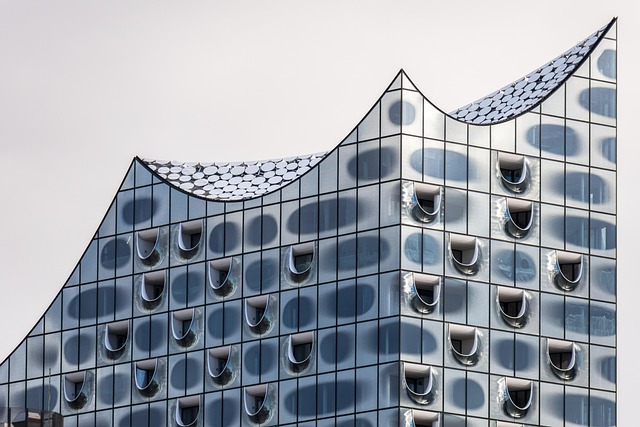Prefab roofing for homes is transforming construction with its seamless integration, aesthetic consistency, and numerous advantages. Traditional methods disrupt structures' character, but prefab systems offer faster builds, minimal site disruptions, and uniform aesthetics. Manufactured in controlled settings, these roofs are durable and easy to install, providing cost savings and peace of mind. Advanced manufacturing techniques ensure precise measurements and customization, making them ideal for both new construction and renovations. Case studies demonstrate successful implementations, proving prefab roofing's versatility and efficiency in modern builds and historic retrofits.
Seamless integration of prefab roofing with existing architectural designs is transforming the residential construction landscape. This approach offers numerous advantages, from speed and cost-efficiency to enhanced structural integrity and design flexibility. In this comprehensive guide, we explore the growing demand for seamless integration in architecture, delve into the benefits of prefab roofing for homes, outline crucial implementation factors, highlight cutting-edge techniques, and showcase inspiring case studies. Discover how modern innovations make it easier than ever to incorporate prefab roofing seamlessly into diverse architectural styles.
Understanding the Need for Seamless Integration in Architectural Designs
In today’s fast-paced construction landscape, there’s a growing need for architectural solutions that seamlessly blend with existing structures, especially when it comes to prefab roofing for homes. Traditional building methods often leave visible seams and structural differences, creating an inconsistent look and feel. This is particularly problematic in areas where historical or culturally significant buildings coexist with modern developments.
Seamless integration ensures a harmonious architectural design, preserving the integrity of both old and new structures. Prefab roofing systems designed for seamless installation offer several benefits: they reduce construction time, minimize site disruptions, and provide a uniform aesthetic appeal. This approach is not only efficient but also preserves the character of neighborhoods and respects the original architectural vision while accommodating contemporary design elements like energy-efficient insulation and advanced roofing materials.
Advantages of Prefab Roofing in Residential Buildings
Prefab roofing offers a multitude of advantages for residential buildings, making it an increasingly popular choice among homeowners and architects alike. One of the key benefits is its seamless integration with existing architectural designs. Unlike traditional roofing methods that can be time-consuming and disrupt the overall aesthetic, prefab roofing components are designed to fit perfectly into any building plan. This allows for a smoother construction process, minimizing site preparation and labor costs.
Additionally, prefab roofing for homes provides superior durability and longevity. Precisely manufactured in controlled environments, these roofs are built with high-quality materials, ensuring they withstand various weather conditions. The modular design also makes them easy to install, replace, or repair, offering peace of mind and long-term cost savings for homeowners.
Factors to Consider for Successful Implementation of Prefab Roofing
Techniques and Innovations Enabling Seamless Integration
In today’s architectural landscape, seamless integration with existing designs is not just an aesthetic preference but a necessity. Techniques such as modular construction and prefab roofing for homes have emerged as game-changers. These innovative approaches allow for precise, efficient, and cost-effective additions or renovations, ensuring the new elements blend flawlessly with the original architecture.
Prefab roofing, for instance, offers a variety of benefits. It can be designed to match the existing roofline, utilizing identical materials and styles, thus maintaining the building’s visual harmony. Advanced manufacturing techniques enable precise measurements and customization, resulting in a perfect fit without the need for extensive on-site modifications. This not only streamlines construction but also minimizes potential errors, ensuring the final product is as intended—a seamless extension or replacement of the original architectural design.
Case Studies: Real-World Examples of Seamless Prefab Roofing Integration
In recent years, prefab roofing has emerged as a game-changer in the construction industry, offering both efficiency and aesthetic appeal. Several real-world examples highlight the seamless integration of prefab roofing with existing architectural designs. For instance, a case study of a modern residential project in urban areas showcases how prefabricated roof panels were used to create a stunning, curved roofline that complements the sleek, minimalist design of the home. The prefab roofing system not only reduced construction time significantly but also allowed for complex geometric shapes without compromising structural integrity.
Another notable example involves the retrofitting of a historic building with prefab roofing solutions. In this project, a delicate balance was struck between preserving the original architectural character and incorporating modern amenities. The prefabricated roof system, designed to mimic the look of traditional shingles, seamlessly blended into the existing facade, ensuring both visual harmony and improved insulation and energy efficiency. These successful implementations demonstrate the versatility and adaptability of prefab roofing for homes, making it a viable option for both new constructions and renovations alike.
Seamless integration of prefab roofing into architectural designs is not just a trend, but a necessity for modern construction. As evidenced by the factors, techniques, and case studies discussed, successful implementation offers numerous advantages for residential buildings. By understanding the need and considering essential factors, architects and builders can leverage the innovations in prefab roofing to create stunning, functional spaces that enhance property values. The real-world examples showcase how seamless integration can transform architectural landscapes, making prefab roofing a game-changer for homes.
